
The Nikon 35Ti is a high quality 35mm point and shoot camera that was marketed towards high society folks through the 1990s. It came out in 1993, and was very expensive for back then, almost $1000; that’s about $1800 in 2018! This little camera had some impressive features for a pocket camera; such as six-segment 3D matrix metering, 833 step active infrared auto focusing, a titanium body, and a superb 35mm F/2.8 six element lens. If you want a wider lens, check out the 28mm version here.
I’ve had this camera since about 2014 and use it quite often when traveling; it’s small and never gets in the way, plus I know all the pics will come out good, and I won’t need to waste time checking out my pictures when I get back to the hotel room at night like we all do with digital, right?
For those of you that want a pocket point and shoot camera capable of taking razor sharp pictures, and getting properly exposed slide film; this is your dream come true!!
With the introduction out of the way, let’s check out the Nikon 35Ti specs.
Name; Nikon 35Ti Quartz Date
Manufactured by; Nikon Corporation, Tokyo, Japan.
Date of manufacture; 1993.
Price; originally retailed around $1000 new, street prices were less, as well as mail order places like B&H Photo. A 1999 photo magazine ad showed a price of $649. Current eBay prices range anywhere from $300 to $600 depending on condition and if it comes with the original box etc.
Build material; appears to be mostly metal with a quality fit and finish.
Box contents; Soft case, instruction manual in multiple languages, and strap.
Weight; camera only, 10.9oz (310g),
Dimensions; 4.7″ (118mm) wide, 2.6″ (66mm) tall, and 1.4″ (36mm) deep.
Focal length; 35mm.
Aperture; F/2.8-F/22 automatically or manually set.
ISO; 25-5000 DX coded. Non DX film automatically set to 100.
Focusing distance; 16″ to infinity, or 0.4m to infinity.
Viewfinder; bright and clear, but frame lines are hard to see unless you’re in bright light; however, a red light comes on in low light when you half press the shutter button. It also has auto parallax correction using different frame lines for close focus, slightly longer focus, and longer distances; plus panorama mode too; all appearing magically when you focus within those distances. More items in the viewfinder are the shutter speed, metering mode, EV compensation active only, not set value, flash indicator, and ‘H’ for too bright warning, or ‘L’ for not enough light. You can customize the viewfinder to your hearts desire if you feel like screwing around with the tiny buttons all day.
Approximate resolution; good film will make very sharp 11×14″ prints. See sample images farther down the page.
Lens; 35mm F/2.8; multi-coated 6 elements in 4 groups, symmetrical double-Gauss design.
Shutter and speed; automatic between the lens 7 blade aperture; electromagnetic shutter, 2 seconds to 1/500 sec in ‘P’ mode at small apertures, and a maximum of 1/250 in ‘A’ mode. Has a ‘LT’ mode which works like bulb mode for up to 10 minutes.
Features; 3D six segment matrix metering. Full program auto mode, aperture priority, and long time mode up to 10 minutes. Exposure compensation in +2EV, -2EV in 1/3 stop increments. Anytime fill flash, Red eye reduction, slow sync uses anytime fill flash, auto, and flash off options. Mid roll rewind. Ten second self timer. Dorky date imprinting, yuck, it ruins the image, don’t use it.
Film; standard 35mm cartridges.
Flash; recharges in about 7-8 seconds, range of about 29′ (9m) with ISO 100 speed film.
Power; uses one CR123a 3V lithium battery. Expensive in the grocery store, but about $2-3 a piece at these shops; B&H, Amazon, eBay. Manual states the battery will last for up to 18 rolls of 36 exposure film with half the shots using flash.
Accessories for this model; -1 diopter built in the camera, but +0.5 eyepiece is available according to the manual; I’ve never seen one listed on eBay.
Crippling features and omissions; buttons are too small, and are almost useless for people with large hands. No filter threads or hood.
Good features; super sharp lens, 3D matrix metering and 833 segment focusing. Also allows exposure compensation and long exposure feature, excellent for a point and shoot camera.
Go here to see the owners manual, and make sure you tip the webmaster.
Product shots with descriptions. Click pictures for larger versions. Note: new product shots added 12/1/18; I didn’t like the blue background on the old ones.

Lens extended and ready to shoot. Tiny flash on and off buttons on right side in picture.
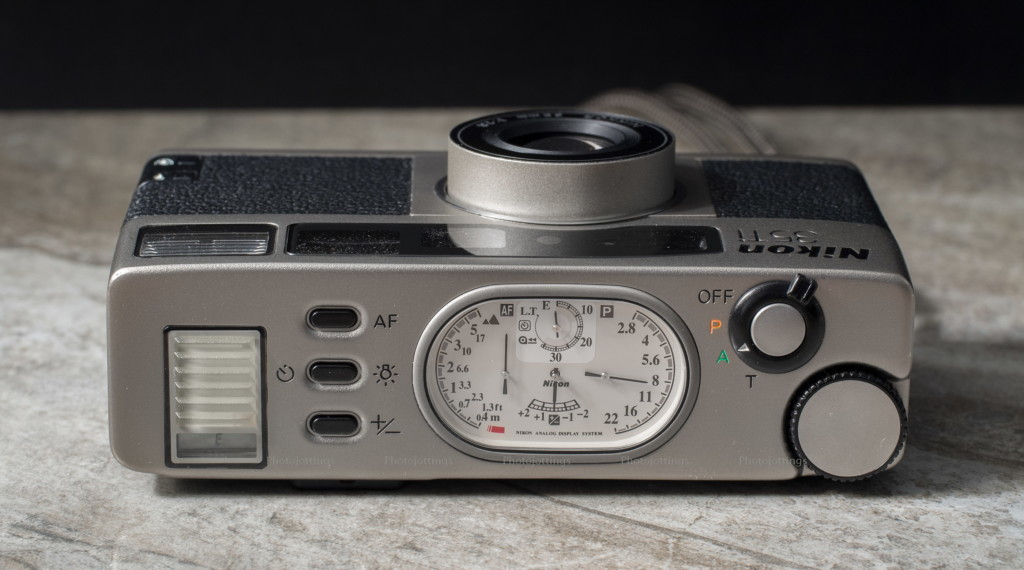
Top cover with lots of buttons. Tiny LCD on left, above that is the window for illuminating the viewfinder info. Next are the AF, timer/dial light, and exposure compensation buttons, analog dials for focus distance, aperture timer and exposure compensation. Shutter button surrounded by switch for ‘P’ program mode, ‘A’ aperture priority mode, and ‘T’ time mode. Wheel on lower right is for adjusting dials.
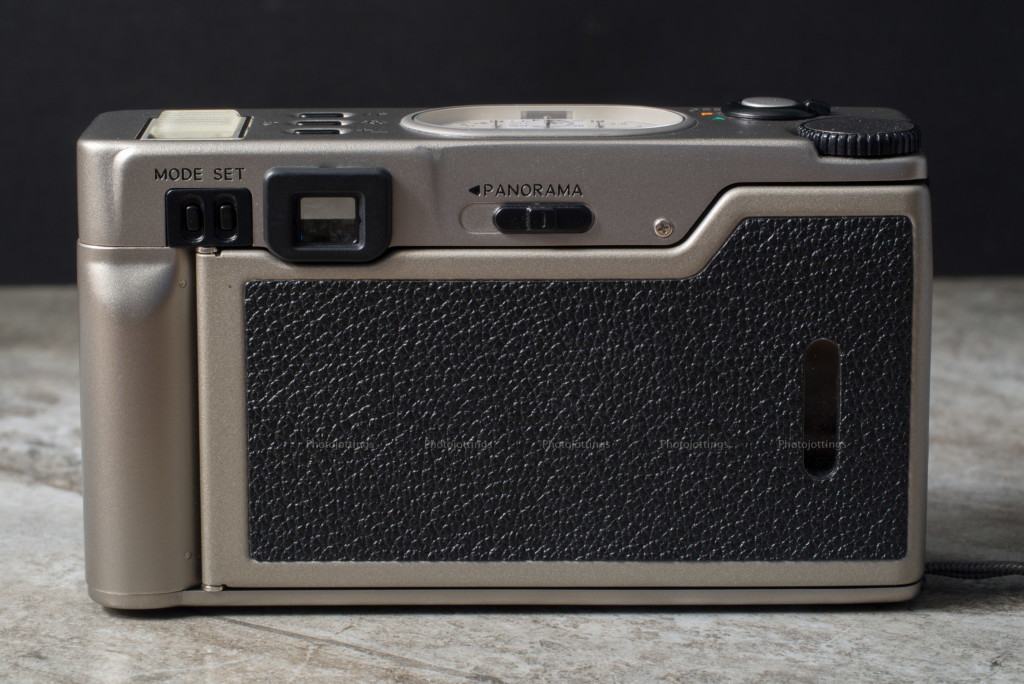
Tiny mode and set buttons that are hard to push, good luck setting things up, I gave up after the first hour of fooling with it. Next is the viewfinder, which is bright and easy to see through. To the right of that is the dumb panorama button that chops off the upper and lower parts of the image, tape this over when in the ‘off’ setting to the right. The window to the right on the back is for seeing the type of film you have loaded; much like a film reminder slot.
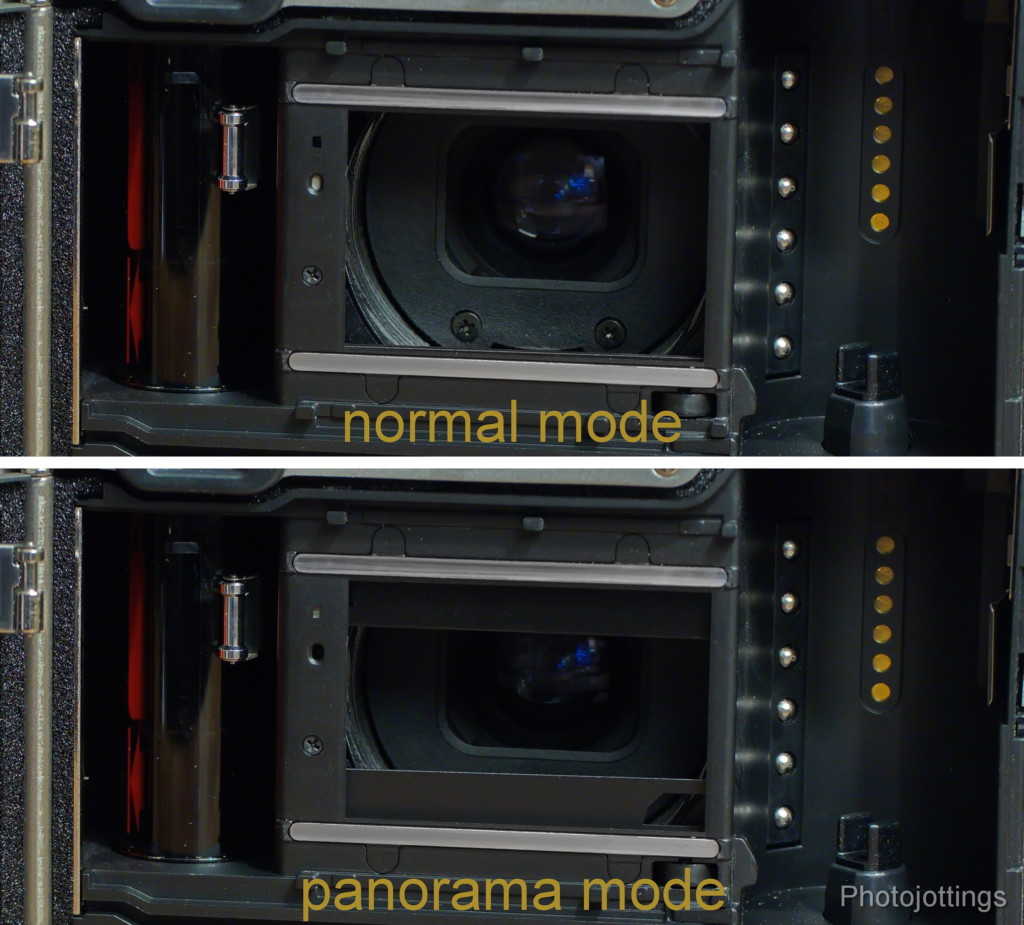
Panorama mode metal curtains extend inward when you move the switch to the left.
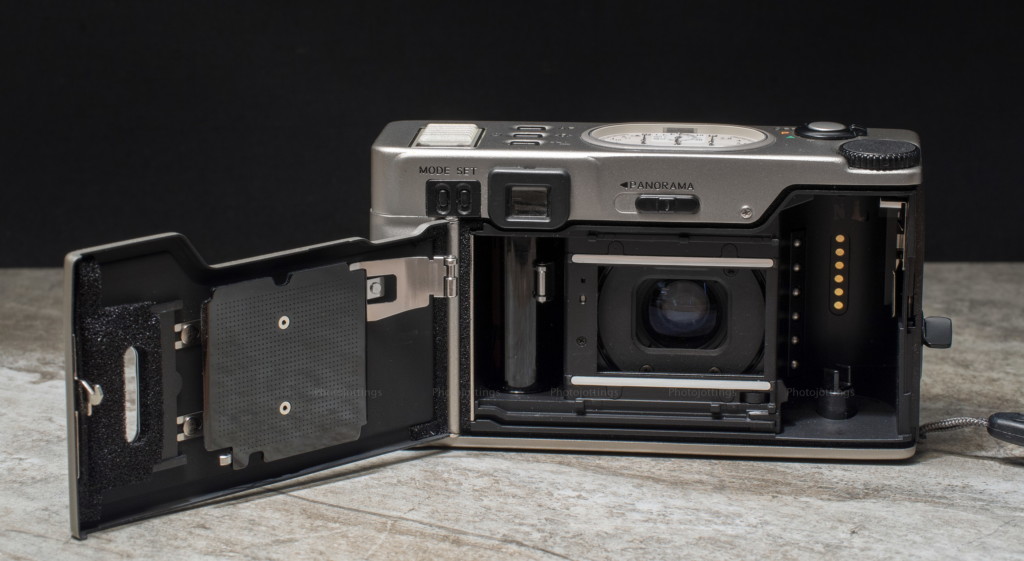
Film goes in upside down (right side) as compared to most 35mm cameras; back opening tab on right side.

Off-center tripod socket, small black dot is mid-roll rewind; to the right is the coin cover battery compartment using one CR123a battery. Red-eye reduction sliding switch around the corner from the flash on-off switches.
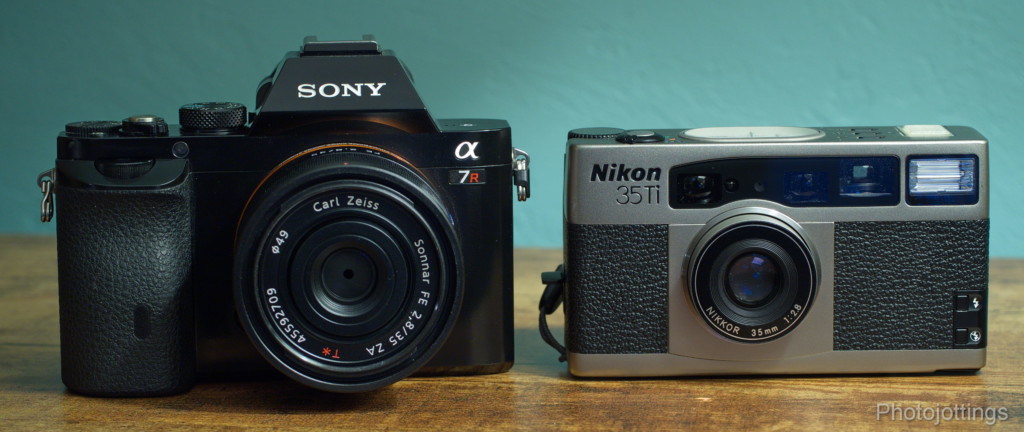
Expensive modern small mirrorless camera on left with same spec lens. Even smaller film camera on right with much higher quality lens.

Fuji Provia 100F, I think at F/8. 3800 pixels wide.

Kodak Portra 400, F/2.8, focused slightly in front of the kids. 4000 pixels wide.

Hand held at F/2.8, 1/15 second with Fuji Provia 100F film. 4000 pixels wide.

Cropped some, using cheap Kodak Gold 200 film, probably F/8. 3300 pixels wide.

Ilford Pan F plus 50. Probably F/5.6. 4000 pixels wide.
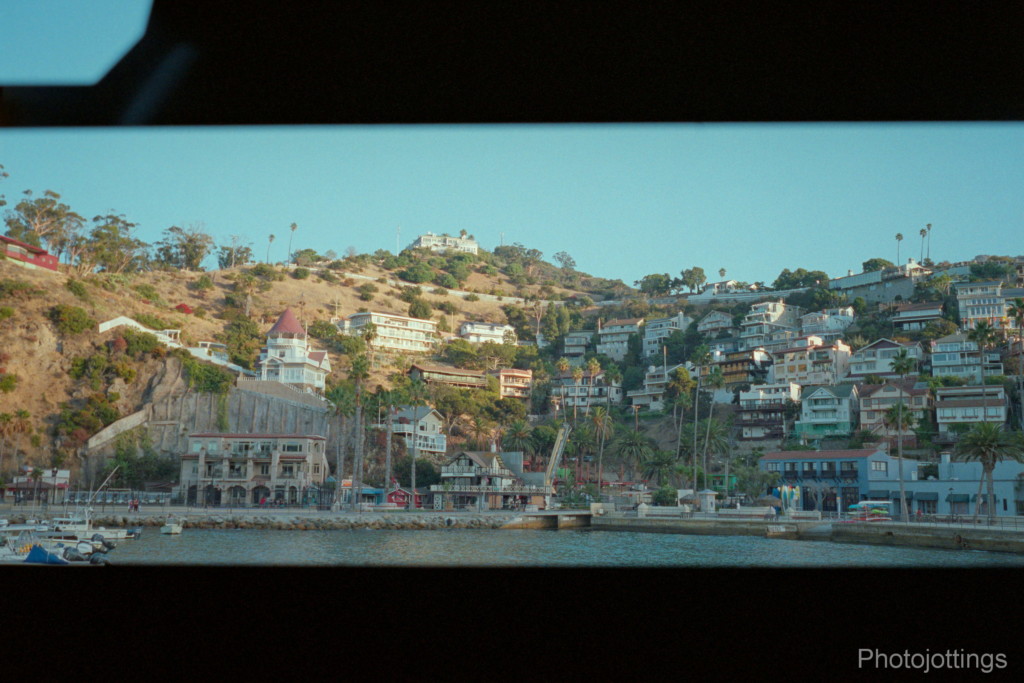
Full image of panorama mode, this is what you see on your developed film. 2400 pixels wide. The shop would only print the panorama scene, not the whole thing as you see here.

Stupid date imprinting on picture; I forgot to turn it off. Fuji Provia 100F. Super sharp image, even in the corners! F/4 or F/5.6, 4000 pixels wide.

Cheap Kodak Gold 200, probably F/8. Very sharp for cheap print film. 4000 pixels wide.

Strong rainbow flare and big bluish blob when strong sun is in picture. Probably F/8.
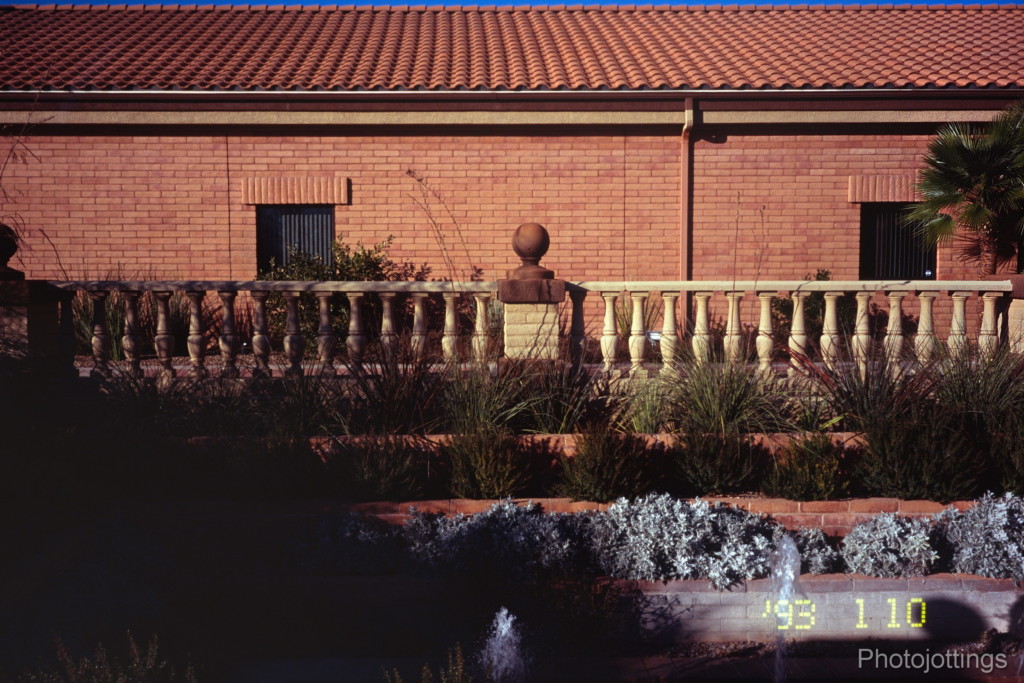
Just a tiny bit of pincushion distortion, although hardly noticeable along this roof line.

Ilford Pan F plus 50. F/2.8 fairly close focus. Notice ‘busy’ bokeh in the tree leave above. 3000 pixels wide.
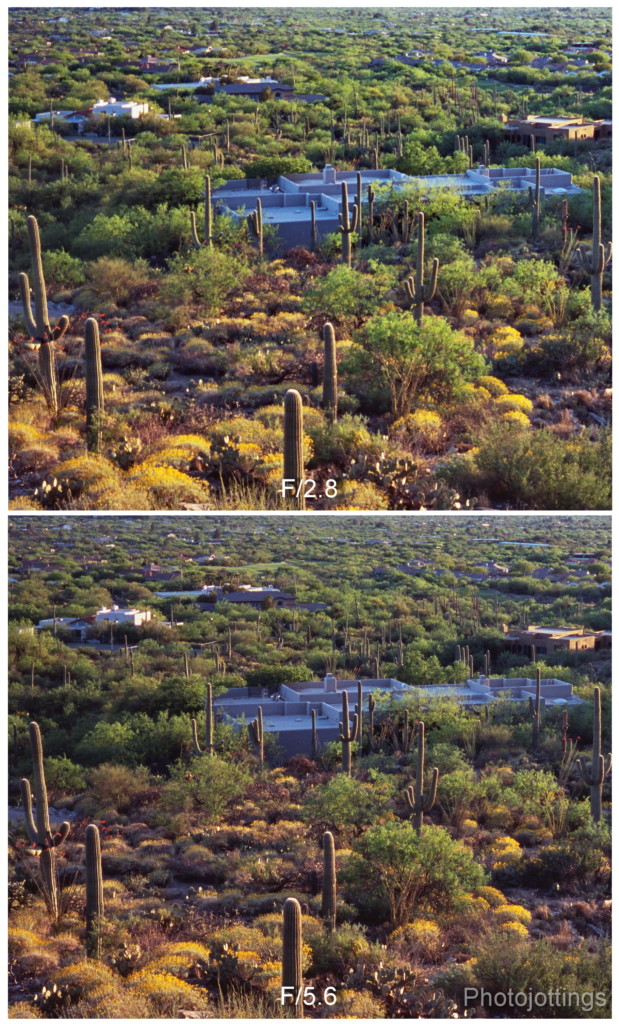
Fuji Velvia 100. Top crop shows F/2.8, bottom at F/5.6. The lens is just a little soft at F/2.8, but totally usable; and very sharp at F/5.6. The lens is maxed out at F/4-5.6 as far as resolution goes.

Fuji Provia 100F at 9000 ft (2745m), where white balance is slightly bluish or ‘cool.’ Probably F/8. Notice how tack sharp the image is, even the sides and corners! 4000 pixels wide. Click picture for larger version.
More photos can be found in the Fuji Superia 1600 samples; and Kodak TMAX P3200 review; I used this camera for all the shots.
Note: when I received my camera from half way around the world, I noticed the aperture dial could not be manually set all the way to F/2.8. It would go from F/5.6 to past F/22. The camera worked fine in program mode, but when I set the aperture manually in ‘A’ mode, the shutter speeds seemed way to slow for the indicated aperture. It took me a while to figure out the problem, and here’s what happened; during shipping the box probably got dropped or was roughly handled and the shock caused the dial to relocate to a position other than its original; it was actually two stops off the reading, when set to F/8, it was actually at F/16!! So I needed to reset the aperture dial using the ‘analog display reset’ code. Go here to see the owners manual, page 83 will tell you how to do it. Make sure you tip the site owner.
Conclusion.
The diminutive Nikon 35Ti was one of the very best pocket cameras that came out in the 1990s, and continues to be impressive even in the age of digital; with their massive megapixels that use complex and very expensive lens designs to work well with a sensor instead of film. Ironically, the now 25+ year old Nikon 35Ti has one of the sharpest lenses I’ve ever come across; it just seems much sharper with more contrast along the sides than the newer lenses designed for digital cameras; which oddly are much larger and heavier, see the image with the Sony A7R and Sony FE Zeiss 35mm F/2.8 lens above.
The Nikon 35Ti exposes very accurately with 3D matrix metering, and focuses dead-on with the 833 step IR focus system. I’ve run a lot of rolls through the camera, and never had a badly blown or out of focus shot, whether in ‘auto’ mode or using aperture priority with exposure compensation. Although the camera can easily get perfect results using print film, many cameras have trouble metering for transparency or ‘slide’ film. Fortunately, the Nikon 35Ti exposes slide film with a high degree of accuracy, and that’s the type of film I use most of the time, however, I usually dial in -1/3EV or -2/3EV, depending on the situation to protect the highlights.
Real resolution depends on the type of film and scanner. I’ve used the Nikon Super Coolscan 9000 ED at 3000dpi, for everything here; that gets all the info out of them, and with cropping and leveling, you’ll wind up with approximately 4000×2667 very sharp images, which is plenty for standard magazine covers or even 11×14 or larger prints. You’ll do much better with high contrast, high resolution film, such as Adox CMS 20 II, but that’s a really slow film and tough to shoot, even worse than slide film.
The only real ‘downer’ about this camera is that it won’t take filters (or a hood, but I can live without a hood and just use my hand to shade the sun). Trying to hold up a small filter to the lens doesn’t work, trust me, I blew a roll of film trying. It was a graduated neutral density filter, and I was hoping to get some big puffy cloud detail without under exposing the landscape. Switch to print film for that type of situation. Oh well, one can’t have everything in a pocket camera right?
There’s another version of this camera with a 28mm F/2.8 seven element lens, it’s the Nikon 28Ti.
Anyhow, this camera is a lot of fun, and works great as a point and shoot; it’s reasonably fast for quick shots, and fits in a large pocket for convenience. And thankfully, you no longer have to be rich to be able to afford it, I bought mine for less than $300 a few years ago, but they have gone up steadily the last couple of years. Check out prices here and help support the site!
That’s it for this review, thanks for visiting!